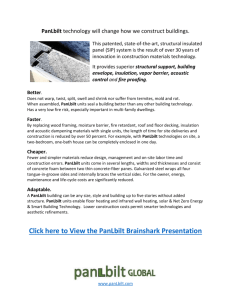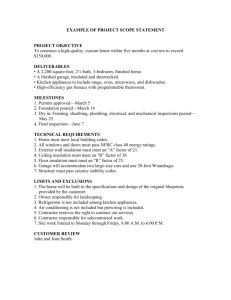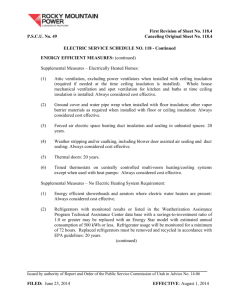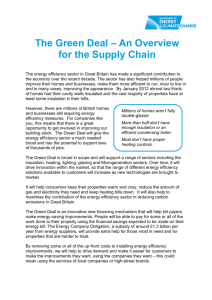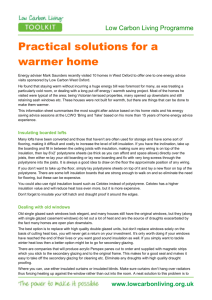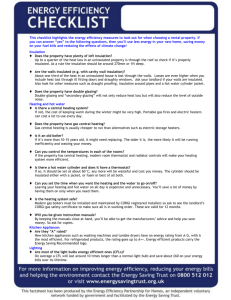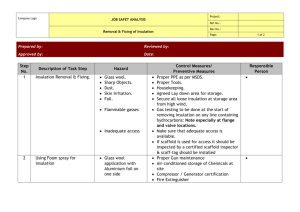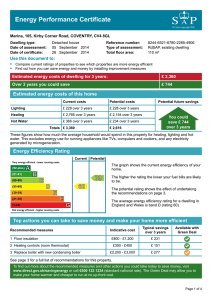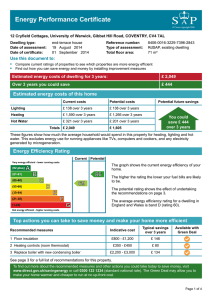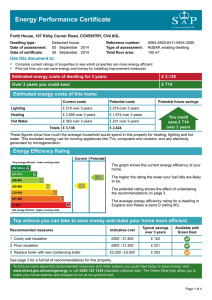Carbonbusting: appliances
advertisement
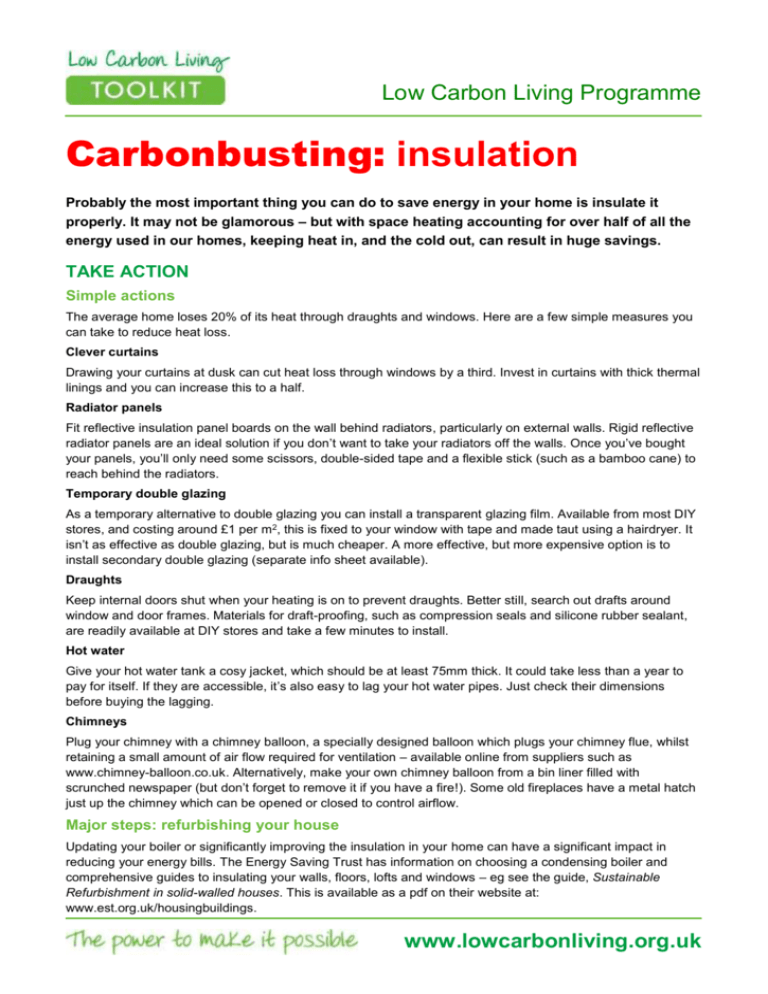
Low Carbon Living Programme Carbonbusting: insulation Probably the most important thing you can do to save energy in your home is insulate it properly. It may not be glamorous – but with space heating accounting for over half of all the energy used in our homes, keeping heat in, and the cold out, can result in huge savings. TAKE ACTION Simple actions The average home loses 20% of its heat through draughts and windows. Here are a few simple measures you can take to reduce heat loss. Clever curtains Drawing your curtains at dusk can cut heat loss through windows by a third. Invest in curtains with thick thermal linings and you can increase this to a half. Radiator panels Fit reflective insulation panel boards on the wall behind radiators, particularly on external walls. Rigid reflective radiator panels are an ideal solution if you don’t want to take your radiators off the walls. Once you’ve bought your panels, you’ll only need some scissors, double-sided tape and a flexible stick (such as a bamboo cane) to reach behind the radiators. Temporary double glazing As a temporary alternative to double glazing you can install a transparent glazing film. Available from most DIY stores, and costing around £1 per m2, this is fixed to your window with tape and made taut using a hairdryer. It isn’t as effective as double glazing, but is much cheaper. A more effective, but more expensive option is to install secondary double glazing (separate info sheet available). Draughts Keep internal doors shut when your heating is on to prevent draughts. Better still, search out drafts around window and door frames. Materials for draft-proofing, such as compression seals and silicone rubber sealant, are readily available at DIY stores and take a few minutes to install. Hot water Give your hot water tank a cosy jacket, which should be at least 75mm thick. It could take less than a year to pay for itself. If they are accessible, it’s also easy to lag your hot water pipes. Just check their dimensions before buying the lagging. Chimneys Plug your chimney with a chimney balloon, a specially designed balloon which plugs your chimney flue, whilst retaining a small amount of air flow required for ventilation – available online from suppliers such as www.chimney-balloon.co.uk. Alternatively, make your own chimney balloon from a bin liner filled with scrunched newspaper (but don’t forget to remove it if you have a fire!). Some old fireplaces have a metal hatch just up the chimney which can be opened or closed to control airflow. Major steps: refurbishing your house Updating your boiler or significantly improving the insulation in your home can have a significant impact in reducing your energy bills. The Energy Saving Trust has information on choosing a condensing boiler and comprehensive guides to insulating your walls, floors, lofts and windows – eg see the guide, Sustainable Refurbishment in solid-walled houses. This is available as a pdf on their website at: www.est.org.uk/housingbuildings. www.lowcarbonliving.org.uk HELP AVAILABLE TO YOU Changing your boiler and improving insulation can involve significant upfront costs. However, grants and subsidies are available from a number of sources – and you don’t have to be on benefits or own your home to qualify for many of them. Offers frequently change, so to find out about current offers check out the following: The Energy Saving Trust website is a good place to start for information about the various schemes available. Or call 0300 123 1234 for independent advice and help. Your local council website, eg http://www.oxford.gov.uk/PageRender/decER/Grants_and_offers_occw.htm Watch out for the Green Deal, a new scheme to help householders fund major refurbishment work. YOUR QUESTIONS ANSWERED Doesn’t filling your cavity wall increase the risk of damp? Previously there was some association between installing cavity wall insulation and increasing damp problems. However, since the 1980s, methods and materials have improved to such an extent that this is no longer the case. These days all cavity wall insulation that is installed by a registered installer is guaranteed for 25 years against damp problems with the Cavity Insulation Guarantee Agency (CIGA). Source: Oxford City Council. I have a small house – are there wall insulation options that don’t take up lots of space? Internal solid wall insulation using plasterboard can significantly reduce heat loss from walls, but the insulating layer can be 6-10cm thick. Insulating wallpaper such as Sempatap is now also available. While this doesn’t provide the same degree of insulation, it is much thinner than traditional internal insulation, and can be fitted by a competent DIYer. Oxfordshire Warmer Walls is a scheme offering a 20% discount on Sempatap: call: 0208 337 0731 to order. What about ventilation? Ventilation is responsible for around 20% of the cost of heating a home. 1 But when insulating your home it’s crucial to retain some ventilation. Houses need to sustain enough airflow to refresh all the air in the house every hour to provide enough oxygen for inhabitants and keep them healthy, allow gas appliances to operate safely, and prevent condensation and mould growth. MYTHBUSTING Isn't it better for me to leave the heating on low while I am out the house rather than turn it off so that the house takes less time to heat up when I return home? No. Leaving the heating on when you are out the house, even on a low setting, means that the boiler will be working continuously when the heating is not needed, and the energy it produces will be wasted. Use the timer to get the heating level back up just as you return (and conversely, turn the heating off a little while before you are due to leave the house to save more energy). FIND OUT MORE Energy Saving Trust website, in particular the following sections: Home Improvements and Products: www.energysavingtrust.org.uk/Home-improvements-and-products Housing Professionals: www.energysavingtrust.org.uk/business/Business/Housing-professionals Practical Refurbishment of solid-walled houses, Published by Energy Saving Trust, 2006 1 Chris Goodall, How to live a low-carbon life, 2nd edition p66, published by Earthscan This work is part of the Low Carbon Living Toolkit and is licensed under a Creative Commons AttributionnonCommercial-ShareAlike 3.0 Unported License. If you have any questions or tips to suggest please email them to us at lowcarbon@hotmail.co.uk v2 24/10/12 Whilst we have made every attempt to ensure the accuracy of this leaflet, this information should not be relied upon as a substitute for formal advice. LCWO will not be responsible for any loss, however arising, from the use of, or reliance on this information. Low Carbon West Oxford is a registered charity 1135225. www.lowcarbonliving.org.uk
